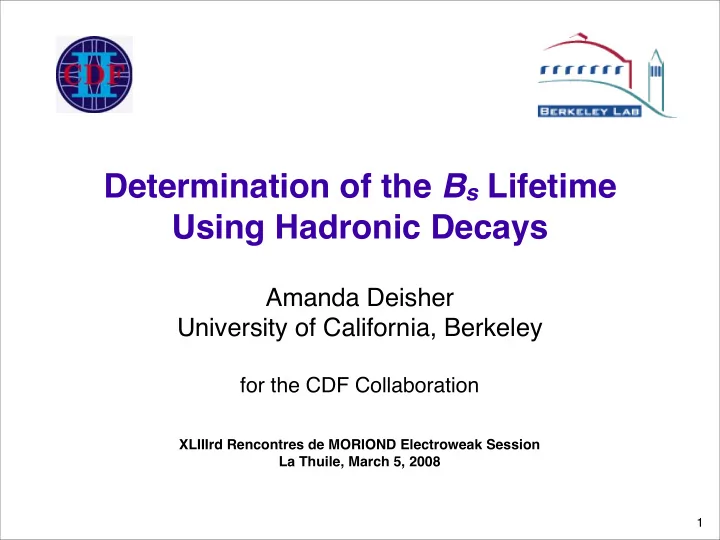

Determination of the B s Lifetime Using Hadronic Decays Amanda Deisher University of California, Berkeley for the CDF Collaboration XLIIIrd Rencontres de MORIOND Electroweak Session La Thuile, March 5, 2008 1
Motivation Spectator model: b mesons and baryons have same lifetime π − Pauli interference, weak annihilation, weak exchange induce lifetime hierarchy b B s D s+ τ ( B c )< τ ( Λ b ) < τ ( B s ) ≅ τ ( B 0 ) < τ ( B + ) s s Experimental status: τ (B + ) τ ( Λ b ) τ (B s ) τ (B 0 ) τ (B 0 ) τ (B 0 ) Theory 1.06±0.02 1.00±0.01 0.86±0.05 0.939±0.021 Exp. 1.071±0.009 0.921±0.036 Tevatron experiments in great position to provide feedback to theorists on τ (B s ) ! PDG (2007): 1.437 + 0.031 - 0.030 ps Included in PDG 2007 τ ( B s ) D ∅ (2006): 1.398 ± 0.044 + 0.028 - 0.025 ps CDF II J/ ψφ (1.7 fb -1 - Aug 2007 ): 1.52 ± 0.04 ± 0.02 ps New! Today: Update of CDF hadronic measurement CDF II Hadronic (360 pb -1 ): 1.60 ± 0.10 ± 0.02 ps A. Deisher 2
Hadronic Trigger Strategy Decay mode of interest: B s → D s- ( φπ - ) π + Separating heavy B mesons from prompt backgrounds Take advantage of long lifetime Trigger on displaced vertex ( > 200 μ m) Trigger and analysis selections modify the proper time distribution 1 1 − ( ct − ct ′ )2 1 1 − ( ct − ct ′ )2 − ct ′ − ct ′ c τ ⊗ t ′ c τ ⊗ t ′ √ 2 σ 2 √ 2 σ 2 Trigger Cuts c τ e 2 πσ e c τ e 2 πσ e · eff( ct ) Analysis Cuts c τ (cm) c τ (cm) ct (cm) ct (cm) Use Monte Carlo to derive “efficiency curve” parameters → fixed in final fit to data 3 − ct � N i · ( ct − β i ) 2 · e e ff ( ct ) = if ct > β i c τ i i =1 A. Deisher 3
Partially Reconstructed Decays Goal: Decrease statistical error (increase statistics) x2 statistics 1. Include more luminosity (360 pb -1 → 1.3 fb -1 ) 2. Use partially reconstructed decays B s → D s- ( φπ - ) π + sample includes partially reconstructed B s → D s- ( φπ - )X decays ✦ tracks not reconstructed or wrong mass assignment ✦ doubles the statistics! Corrective “K” factor accounts for missing momentum and mass ct = L xy · m rec B ✦ Good agreement with world · K p T averages ✦ Good agreement between FR and PR regions Procedure tested extensively on B 0 and B + control samples A. Deisher 4
B s → D s- ( φπ - )X Measurement Procedure 1. Perform mass fit to determine fractions 2. Fix fractions in lifetime fit. Fit for c τ ( B s ) only Largest systematic: ✦ background composition (% prompt) ✦ background fraction τ ( B s ) = 1.518 ± 0.041 ± 0.025 ps Most precise measurement to date! Good agreement with recent CDF J/ ψφ result τ ( B s ) [ D s- ( φπ - )X ] / τ ( B 0 ) [PDG] = 0.99 ± 0.03 A. Deisher 5
Summary ✦ Theory of B hadron lifetimes well Flavor Specific Measurements developed. Further experimental input needed for B s . ✦ Trigger on displaced vertices ➡ large B s sample ➡ can account for effect on proper time distribution ✦ Increase statistics using partially reconstructed B s decays ✦ Hadronic lifetime results: * • Improved exp. uncertainties • Good agreement with theory * ✦ Three new high precision B s results! * Not actually a flavor specific mode A. Deisher 6
Recommend
More recommend